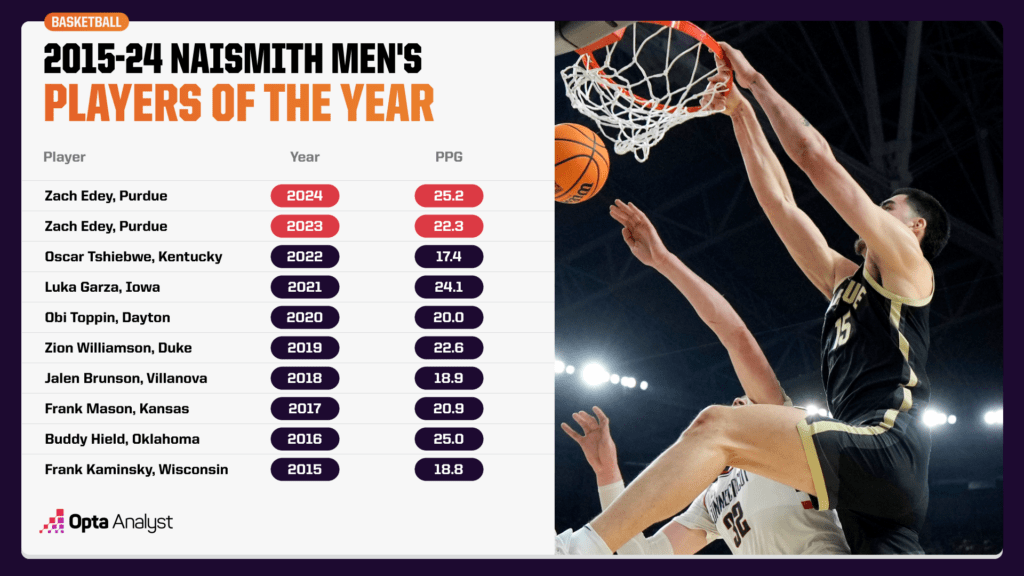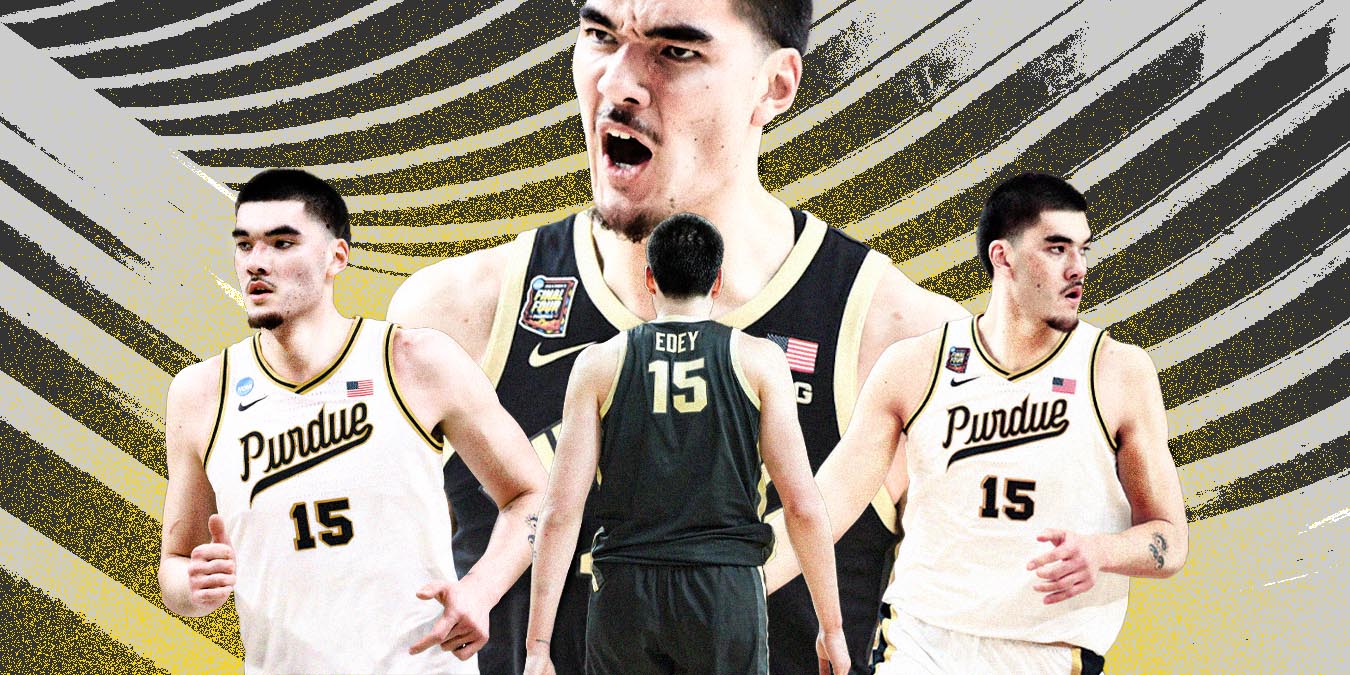There was a time when it was said that Zach Edey wouldn’t be able to play in the NBA. The Purdue big man was then considered a second-round pick at best. But now, he’s projected to be a lottery selection in many mock drafts. So where should he go?
There is always some cognitive dissonance when it comes to elite college players getting drafted into the NBA.
The college season ends, and those that exclusively watch college basketball might be surprised to find out that the best player in the college ranks isn’t considered a top NBA prospect.
The NBA game is different, and, often, teams are right to value potential and certain skills over college production.

But, sometimes, teams ignoring college production miss out on a player like Jalen Brunson. He may not have been the fastest player or had the best shot, but his skills have translated to the NBA in a big way and he’s one of the best guards in the league.
One of the most polarizing of these types of players is in this year’s draft. Zach Edey had an incredible college career with accolades few can match, but there are questions about how the Purdue star’s game translates to the pros.
Is Edey a player whose game will only work in college, or is he, like Brunson, a player whose production will translate to the highest level of basketball? With clear strengths and obvious limitations, there is a case to be made for either.
Why Edey Could Be a Steal
Edey gets compared to a lot of tall slow-footed centers coming into the league, but this undersells just how big he is. Edey came in over 7-foot-3 at the combine with a wingspan close to 7-11. Wingspan measurements can be all over the board, but this should put Edey comfortably in the top five in the NBA in wingspan.
Every inch of wingspan and height is crucial for players who aren’t elite athletes. It seems obvious, but an extra inch of wingspan means you can be one less inch closer to the shooter and still alter the shot the same. It increases the margin for error, and this means the two-time AP College Basketball Player of the Year’s margin for error is higher than almost anyone in the league.
Wingspan and height don’t guarantee success. Tacko Fall and Mo Bamba are two of the tallest and longest players in the league but haven’t been impact guys. But comparing the production or frame of Edey to either of these players is disingenuous. Edey is one of the most decorated players in college basketball history and is an elite post scorer with toughness and enough strength to cause problems for opposing teams.
Post-ups may not be all that common in the NBA anymore against anything other than mismatches, but Edey’s post skills are excellent. His footwork improved every year at Purdue, and even though he still loves going to his right-handed hook moving toward the center of the floor when he posts up, he’s become adept at sealing overplaying defenders with his right leg and spinning inside for an easy dunk or layup.
The counters he displayed this past season will be crucial in the NBA, when his size and strength alone won’t be enough to score on most defenders. His touch around the rim has gotten better with time too. He can win with size or finesse in the post.
Edey’s toughness isn’t just displayed in the post, either. He is a willing and great screen setter, which may seem like a basic skill, but is actually really important for big men in the league. Some big men set phantom screens and start trying to dive or pop early, allowing defenders to easily maneuver around them. Edey uses his massive frame and understanding of where guards want to go to cause real problems for defenders. With as popular as the pick-and-roll is in the NBA, the willingness and ability to screen well is a huge positive.
The big man isn’t an elite passer, but he’s willing and understands basic reads well with all the reps he has gotten in the post. He’ll have to improve decision-making against more sophisticated help defenses, but he’s shown enough of a baseline in his playmaking that it likely won’t be a huge issue.
And for someone who doesn’t have the greatest footspeed, Edey really works to bother offensive players as much as possible. When he is in position near the rim, he understands how to use his frame to alter shots while not compromising his spot on the floor too early.
There are obvious defensive limitations, but, when near the basket, Edey can be a difference-maker.
Why There Are Concerns
So Edey’s a tough player who dominated the collegiate game and can score, pass and alter shots at acceptable levels. At this point, he sounds like a surefire top-10 pick, right?
Not exactly. The glaring limitations of Edey’s game are important when discussing his fit in the modern NBA.
The biggest issue is the slow feet. It’s extremely difficult for Edey to get moving side to side quickly, and any perimeter player with average speed can blow right by him if given space.
His chance of being an impact player on defense at the next level is limited exclusively to drop coverage. If Edey is asked to constantly switch or hedge and recover, he’s going to be too slow to get back to protecting the basket and will constantly be exposed.
Even in drop, defenders can take advantage of Edey’s slow feet with enough space. When a speedy ball handler has a runway against him, he often drops back too far to guard against a blow-by, leaving opponents with easy floaters.
Edey is put in a tough position here and at least forces a floater. But a more athletic center would be able to make this a tougher shot by being more aggressive on the ball.
His reduced versatility is going to cause Edey to drop on a lot of team’s boards. Teams value versatility, and Edey doesn’t have that on offense or defense. He’ll have to be put in very specific circumstances to succeed, and not every team has the personnel or scheme to succeed with him.
There is also the question of how many of Edey’s strengths will be mitigated in the NBA. With some limitations that likely won’t go away, Edey will have to provide a lot of value in the areas he’s good at to be a successful NBA player.
Obviously, he’s not going to be the same offensive focal point in the NBA that he was in college, and his post scoring, while still useful, won’t be nearly as much of a factor as it was at Purdue.
Edey will have to get back on defense more quickly in the NBA with the higher skill level of opponents and the desire to push the pace in transition that so many teams have. Will this cap some of his upside as an offensive rebounder? He was an elite offensive rebounder in college, and losing a significant amount of that value in the pros would hurt.
Why Team Context Is Key
Edey’s success will be more dependent on team context than most other players. He requires a specific defensive scheme and specific types of players around him to succeed.
He has to play in drop with good enough perimeter defenders that don’t leave him compromised at the point of attack to be successful. Offensively, since he’s not a shooter, he’ll need teammates who can shoot and none that clog the lane.
These conditions will cause some teams to pass on him at almost any point in the first round. If he’s not a fit for a team, there’s no sense in trying to mold him into the player you’d like him to be, because his limitations, while likely to improve over time, will always be there.
But this also offers an opportunity for a team that has the right environment for him the chance to get a draft-day steal. If other teams have to pass on Edey because he’s not the right fit for them, he might get pushed down the board a bit. But the team that grabs him will likely get great value from him, because, in the right situation, he has a ton of skills that contribute to winning on both sides of the ball.
So where does our NBA Draft model have him ranked? And who are Edey’s top player comparisons? The model’s rankings are ordered by DRIP, which is a projection of a player’s contribution to his team’s plus/minus per 100 possessions, at the end of Year 4 because that’s when this class is set to play through its rookie contracts.
And though its NBA comparisons are meant to be at the time those players were entering the draft, it does open the imagination to potential projections.
Edey ranks 28th per our model with player comparisons that include former Iowa star Luka Garza, ex-Duke standout Vernon Carey Jr. and former Indiana big man Trayce Jackson-Davis.
Still, it’s easy to see Edey as a rim-deterring, screen-setting big man with a nasty streak that causes headaches for any team that tries to defend him with smaller players. So perhaps more than any other player in this year’s draft, Edey’s value is in the eye of the beholder.
Be sure to check out all our MLB, NBA, college football and NFL coverage. And follow us on X and Instagram for more!
